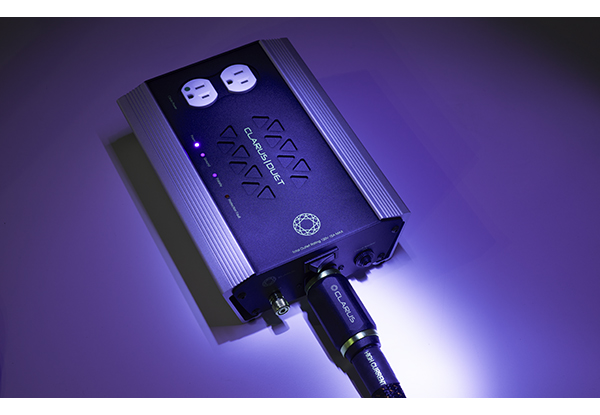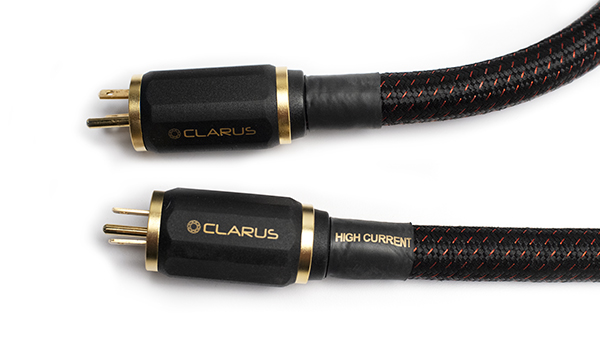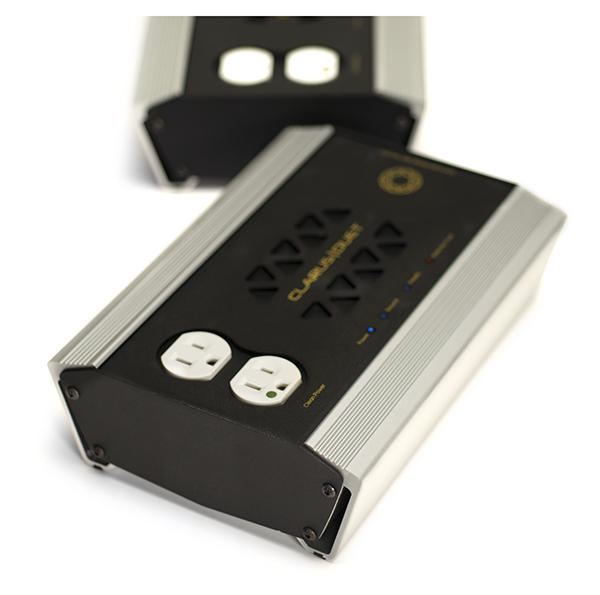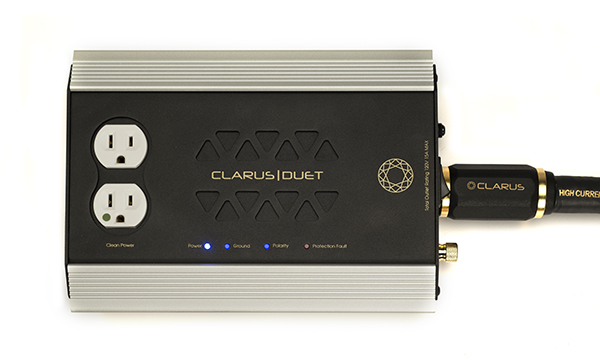The Clarus Duet Power Conditioner
 Power conditioning products can be deceptive. With most, you hear a modest to dramatic reduction in background noise initially and the excitement builds.
Power conditioning products can be deceptive. With most, you hear a modest to dramatic reduction in background noise initially and the excitement builds.
More often than not, when the initial purchase excitement subsides and you listen to a wider range of music something sounds amiss and it’s usually dynamics and musical nuance. Those “inky, black backgrounds” that everyone is buzzing about usually comes at a cost. Different, not better. Pretty soon, you plug your system back into the wall and notice that those lost dynamics are back.
With the Duet, Clarus has eliminated the main problem surrounding many of the power conditioning products out there, building a conditioner with sufficient dynamic range. The massive 30 amp, C-Core inductor at the heart of the Duet offers enough reserve to keep up with large, monoblock power amplifiers and high powered subwoofers. Fortunately, I’ve always got a number of these around, so this was an easy test.
Spoiler alert: The Duet does a fantastic job and exceeds expectation. And it does so at the very reasonable cost of $1,250 each.
These somewhat small power conditioners are deceptive, as soon as you pick them up, they feel a lot heavier than you might think this box would weigh. The layout is simple, with a high quality duplex outlet on the top panel and a 15A IEC socket on the rear face. Aimed at the monoblock power amplifier customer because of its high-current capability, it’s also the perfect choice for anyone using a system built around a single source and high powered integrated amplifier. If you’re just running a DAC and integrated amp, or phono stage and integrated, the Duet is perfect, having more than enough capacity.
You’re gonna want the cables too
Dynamics and musical nuance rely heavily on current capability and delivery. Anything getting in the way of that process, stifles transients and slows things down. The more dynamic ability your system has, the more you will notice this effect. To that end, Clarus offers their Crimson High-Current power cables, at $1,720 each. (6 foot length) Those that can keep their Duet(s) closer to the wall outlet can opt for the 3 foot version, which drops the price substantially to $1,020 each.
 You either subscribe to the theory that power has come all this way to your house, and the last few feet of cable doesn’t matter, or the theory that power is a gigantic well, that you tap into to power your system – and everything matters. If you are in the former camp, you’re probably not even reading this review. I’ve always chosen the latter view, which is why I’ve always embraced having clean power for my system. However, it’s always been the fight of eliminating distortion and artifacts from the power line, versus dynamics. Forced to choose, I’ll take the dynamic freedom, which is why so many power products have fallen by the wayside in the 16 years we’ve been around. The reason you’ve seen so few reviews on power products in TONE hasn’t been for lack of investigation, we just haven’t heard many great ones.
You either subscribe to the theory that power has come all this way to your house, and the last few feet of cable doesn’t matter, or the theory that power is a gigantic well, that you tap into to power your system – and everything matters. If you are in the former camp, you’re probably not even reading this review. I’ve always chosen the latter view, which is why I’ve always embraced having clean power for my system. However, it’s always been the fight of eliminating distortion and artifacts from the power line, versus dynamics. Forced to choose, I’ll take the dynamic freedom, which is why so many power products have fallen by the wayside in the 16 years we’ve been around. The reason you’ve seen so few reviews on power products in TONE hasn’t been for lack of investigation, we just haven’t heard many great ones.
The Duet/Crimson combination does a fantastic job, and at reasonable cost. If it makes budgetary sense, I suggest thinking of the Duet conditioner and Crimson High Current power cord as a system onto itself. The Duet works well solo, offering a substantial improvement over having nothing in the system, but when you add the cord to the mix, the window on your music is open all the way.
Breaking them out, the Duet still offers a substantial improvement in all the musical attributes mentioned, but the Crimson cord takes it all the way. If you can only move on the Duet for now, adding the cord later makes a clear upgrade path.
The test subjects
Putting this quartet of Clarus products to the test, we installed them in one system with the PrimaLuna EVO 400 vacuum tube monoblocks, the Audio Research REF160M vacuum tube monoblocks, the Nagra Classic solid-state monoblocks and a vintage pair of Pass Labs Aleph monoblocks. Each combination yielded similar improvements in low level clarity, lower noise floor and lack of dynamic restriction. However, like nearly every other tube powered amplifier tested, both of the tube amplifiers seemed to have a greater delta in noise floor reduction than the solid state alternatives. This has been very consistent with all of the good power conditioners we’ve tried when connected to tube electronics.
Playing to the dynamic range of all the mono amplifiers tried, the Duets were each plugged into dedicated 20 amp circuits, so they would not be compromised by the power available to them, and connected via the Crimson power cords, with Cardas receptacles. I take this stuff seriously!
More often than not, if a power conditioner passes all the other tests, when pushed hard, in a high power situation, it brings a compression effect not unlike a solid-state amplifier featuring a soft clipping feature. Dynamic peaks when played at high volume merely lose their impact, and the sound field starts to collapse in all three directions, much like a digital recording that’s been normalized. I’m happy to report the Duet scores a perfect ten here, exhibiting none of these problems. A true test of dynamics.
Fortunately, we still had the REL 212SE subwoofers on hand, as well as a pair of their newest S/510s in the living room system, so this offered an additional confirmation on Clarus’ claims. Plugging your subwoofer into a Duet (or Duets, if you have multiple subs) offers a different, yet equally exciting improvement. Called upon to usually work from about 60hz on down, it’s tough to hear a reduction in noise floor.
The improvement here, is strictly in speed and texture. Every single one of the subs we tried, even down to entry level REL and Paradigm subs (both under $1000) offered the same qualitatitve improvement. You’ve probably got your favorite bass heavy tracks, and the funkier the bass line, the more you’ll hear what the Duet brings to the presentation. It’s easier to hear fingers plucking and slamming bass strings, and it becomes easier to hear the different cabinets that bass players use, instead of just hearing one-note bass.
Wait for it
Like so many other products of this ilk, you will notice a lower noise floor immediately. Using the Duet/Crimson combination provides an effect much like listening to a favorite musical selection in 16/44 resolution, and then immediately hearing it again in 24/96, and going right back. There’s a sense of space in the high resolution, with an accompanying ease that the standard resolution track simply does not have. And, then it’s tough to go back.
Playing a long list of drum and percussion heavy tracks, selections that really tax a power amplifier make it a lot easier to hear what the Duet/Crimson bring to the presentation. The leading and trailing edges of transients are now reproduced with far less effort. From a psychoacoustic sense, there’s much less fatigue, and having the Duet/Crimson in the loop makes it that much easier to relax, engage the music, and forget you are listening to components. That’s what makes this product worth the asking price. This level of clarity is something you can’t get another way.
For all the audiophiles carrying on about the importance of source components, I submit that starting with clean, distortion free power is the ultimate attention to the source. No matter how massive the filter capacitors in your power amplifier are, they aren’t cleaning it all up.
It’s always hard to make a value judgement for you. However, in the context of a $10k – $30k system, a pair of Duets moves the scale more than far enough to feel like a great value. The Duet probably offers 75% of the improvement, with the cords adding the rest. Considering how much power these are capable of passing through, it’s not the worst idea to install a couple of premium power outlets to go with your Duets, just so you are getting everything they are capable of delivering.
The Clarus Duet power conditioner(s) are one of the best performing I’ve heard at any price, doing no harm to the musical content and revealing more music than your system is capable of without them in place. Deceptively simple, this is no easy feat. That they do this for $1,250 each, makes them highly worthy of one of our Exceptional Value Awards for 2020. I’m keeping this pair, so you’ll be seeing them as associated components going forward, permanently attached to our PrimaLuna EVO400 monoblocks.
www.clarus.com




